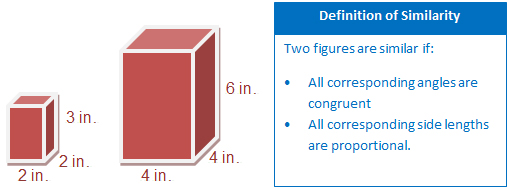
As with planar figures, 3-dimensional figures can be similar as long as the definition of similarity is met. Consider the two right square prisms below.

To determine whether or not the solids are similar, verify both conditions of similarity.
Condition 1: All corresponding angles are congruent.


Condition 2: All corresponding side lengths are proportional.
small height large height = 3 in. 6 in. = 1 2
small length large length = 2 in. 4 in. = 1 2
small width large width = 2 in. 4 in. = 1 2
Since the ratios are all equal to 1 2 , they are equal to each other.

The two cylinders shown are similar. Use the measurements shown to determine the height of the smaller cylinder.
Step 1: Identify the scale factor used to generate the smaller cylinder from the larger cylinder. Use a pair of corresponding measures that you know to set up a ratio. Drag the measurements from the figure to the appropriate place in the ratio below.
Step 2: Use the ratio from step 1 to set up a proportion containing the missing dimension that you are trying to find. Drag the appropriate measures to the proportion boxes shown below.
![]()
Step 3: Now that you have two equal ratios, you have a proportion. Solve the proportion.
A pair of three-dimensional figures is classified as similar solids when they are the same shapes and their corresponding measurements are proportional. The ration that compares the measurements of the two similar solids is called the scale factor.